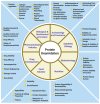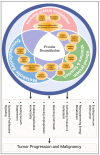Advances in the Study of Protein Deamidation: Unveiling Its Influence on Aging, Disease Progression, Forensics and Therapeutic Efficacy
- PMID: 40559997
- PMCID: PMC12196754
- DOI: 10.3390/proteomes13020024
Advances in the Study of Protein Deamidation: Unveiling Its Influence on Aging, Disease Progression, Forensics and Therapeutic Efficacy
Abstract
Protein deamidation, a nonenzymatic post-translational modification that converts asparagine and glutamine residues into their acidic forms, such as aspartic acid, iso-aspartic acid, or glutamic acid, has emerged as a pivotal process affecting protein stability and function. Once considered a minor biochemical occurrence, deamidation is now recognized for its significant role in aging, age-associated diseases, disease progression, cancer, and therapeutic efficacy. This review explores the recent advances in understanding protein deamidation, its impact on cellular homeostasis, protein misfolding, and age-related and chronic diseases including neurodegeneration and cancer. The study also highlights the challenges posed by deamidation in biopharmaceuticals, where it compromises therapeutic stability and efficacy. Advancements in state-of-the-art analytical techniques and computational approaches for identifying deamidation sites and predicting deamidation-prone regions are discussed, along with deeper insights into how deamidation affects protein structure and function. Based on the current insights, this review underscores the dual role of deamidation as both a natural regulatory process and a contributor to pathological states, providing a roadmap for future research in aging biology, disease mechanisms, and therapeutics.
Keywords: aging; biopharmaceuticals; cancer; deamidation; dementia; forensics.
Conflict of interest statement
The author declares no conflicts of interest.
Figures



Similar articles
-
Health professionals' experience of teamwork education in acute hospital settings: a systematic review of qualitative literature.JBI Database System Rev Implement Rep. 2016 Apr;14(4):96-137. doi: 10.11124/JBISRIR-2016-1843. JBI Database System Rev Implement Rep. 2016. PMID: 27532314
-
Psychological interventions for adults who have sexually offended or are at risk of offending.Cochrane Database Syst Rev. 2012 Dec 12;12(12):CD007507. doi: 10.1002/14651858.CD007507.pub2. Cochrane Database Syst Rev. 2012. PMID: 23235646 Free PMC article.
-
Accreditation through the eyes of nurse managers: an infinite staircase or a phenomenon that evaporates like water.J Health Organ Manag. 2025 Jun 30. doi: 10.1108/JHOM-01-2025-0029. Online ahead of print. J Health Organ Manag. 2025. PMID: 40574247
-
The use of Open Dialogue in Trauma Informed Care services for mental health consumers and their family networks: A scoping review.J Psychiatr Ment Health Nurs. 2024 Aug;31(4):681-698. doi: 10.1111/jpm.13023. Epub 2024 Jan 17. J Psychiatr Ment Health Nurs. 2024. PMID: 38230967
-
Signs and symptoms to determine if a patient presenting in primary care or hospital outpatient settings has COVID-19.Cochrane Database Syst Rev. 2022 May 20;5(5):CD013665. doi: 10.1002/14651858.CD013665.pub3. Cochrane Database Syst Rev. 2022. PMID: 35593186 Free PMC article.
References
Publication types
LinkOut - more resources
Full Text Sources

